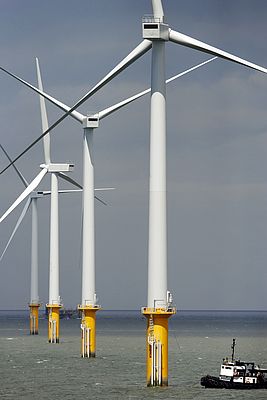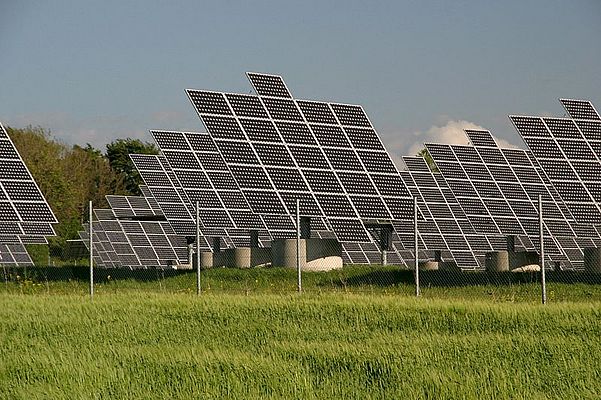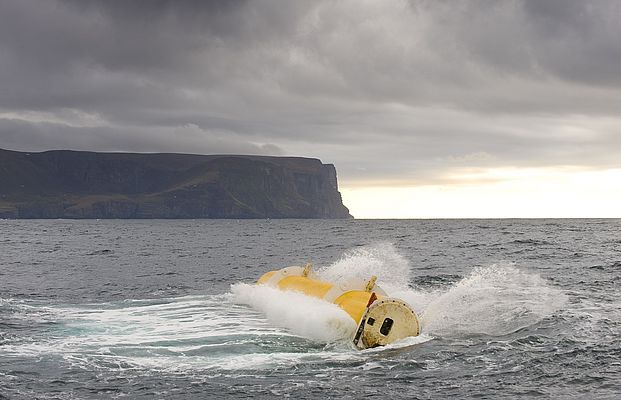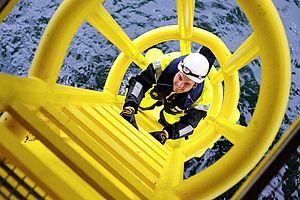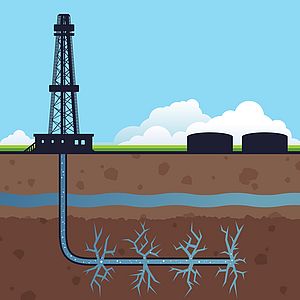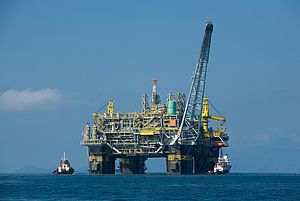They are available without limits and environmentally friendly – renewables have all the arguments on their side. However the utilization of renewables has so far only had a strong start, they still have to be developed. Yet there are numerous plans to increase mankind’s use of power from renewable forms energy. This is an opportunity the valve industry may not miss and will not miss – the investments being made in wind, solar and geothermal energy, biogas and hydro power are far too profitable.
The advocates of renewables have been knocking on politician’s doors for decades. At first to no avail – governments continued to use fossil energy, such as gas, oil, coal, as well as nuclear power. In the end however, they were not able to close their eyes to the frightening fact that fossil energy releases carbon dioxide (CO2), which weakens the ozone layer, contributes to global warming and thus displaces climate zones. Rising sea levels, frequent weather extremes such as droughts and flood, spread of parasites and tropical diseases are a threat to mankind.
Fossil power and nuclear technology still are the mainstays of supply. They will nonetheless be replaced when the oil and gas reserves near depletion. Half of the world’s extractable oil reserves will have been used up in 15 years, according to the German Federal Institute for Geosciences and Natural Resources. Natural gas will only last until 2070 if extraction stays at the current level.
EU starts an energy revolution
The European Union (EU) has already started an energy turnaround. A new directive was passed last year, stating all member states should expedite renewables in the areas electricity, heat, coldness and traffic. The directive‘s goal is for renewables to attain a share of 20 percent of the EU’s total energy consumption by 2020. At the same time, carbon monoxide emissions are to be cut by 20 percent and energy efficiency is to be enhanced by 20 percent over the course of the next ten years.
Experts from Shell International acknowledge the slow, yet certain change. The energy mix is changing in favour of renewable forms of energy. By 2050 renewables will have a 33 percent share of global supply.
Wind and sun energy are especially seen as the driving forces behind the current developments. Worldwide turnover of wind power is estimated to be worth more than 80 billion euros in ten years time, solar energy is expected to account for a volume of around 60 billion euro.
Large-scale projects are fuelling such forecasts. The youngest impressive example is the North Sea wind farm „Alpha Ventus“, which has been giving equipment and valve manufacturers a gush of fresh air. Twelve wind turbines placed 45 kilometres off the coast of the Island of Borkum will at first form Germany’s first offshore wind farm.
A new era is seen to be beginning with this pioneer work. The German Engineering Federation VDMA calls the project a milestone. Alpha Ventus makes clear, that large-scale wind farms are also possible offshore, far away from the coast with depths of up to 17 metres. The operators are rewarded with electricity won from the unceasing sea breeze. In the case of „Alpha Ventus“, a consortium composed of Ewe, Eon and Vattenfall Europe invested 250 million euro in the test area.
„Alpha Ventus“: a flagship project
Wind turbines are shooting up all over. Last year, a wind farm called „Horns Rev 2“ was built off the Danish coast, with 91 wind turbines and a total capacity of 209 megawatts. „Finngrunden“ off the coast of Sweden has even more than 300 turbines with a capacity of 1.500 megawatts. Great Britain is also boosting its use of wind power. Germany is trying to keep up with „Alpha Ventus“, where twelve turbines will account for a capacity of 60 megawatts.
„Alpha Ventus“ has remarkable dimensions. The wind engines have a hub height of 90 metres above sea level. Including the rotor gives the turbines a height of around 155 metres, plus additional 30 metres depth to the sea bed. Substation platforms are also located on site. These again need valves for diesel tanks and leak-oil tanks.
REpower uses ball valves with nominal sizes between 2“ and 2 ½“ as shutoff devices in its wind turbines. Manometers with a pressure range of up to 180 bar are also used. The valves are used in the oil and water cooling circuit. „Special requirements are the corrosion resistance for offshore installations and the serviceability of valves after extended periods of not being used“, explains Rebecca Lange of REpower Systems AG.
Products for wind turbines include pressure accumulators, tubes, fittings, screwed joints, special hydraulic cylinders and pumps as well as filters. Freudenberg Dichtungs- und Schwingungstechnik for instance ships intelligent shaft seals for pitch gears in wind turbines. A Simmering sealing system with an integrated leakage sensor makes it possible to remotely check the shaft seal. The SKF Economos Group has also discovered wind energy as a sector.
Back to „Alpha Ventus“: experts believe the project will provide valuable knowledge for the use and future development of offshore wind power. The overall project is gigantic: „Our goal is an installed offshore capacity of 25.000 MW by the year 2030“, announced Germany’s Federal Environment Minister Dr. Norbert Roettgen.
„Desertec“ makes a point
Solar-thermal energy is also on the rise. Yet it will take some time for it to be rolled out – the valve industry has to be patient. The Desertec project caused an uproar just recently, as it will utilise the Sahara desert as a source of energy for Africa and Europe. The idea is that solar power plants will produce energy nearly without limits, for a stable price and without CO2 emissions. 15 major corporations have started cooperating to check the project’s feasibility. A concrete plan might be presented within three years. An investment of 400 billion euro would have to be made to realise the project. Experts believe Europe could feed 15 percent of its power requirements from the solar collectors in the desert.
A solar circuit consisting of collectors with a buffer circuit and a buffer is a standard for large solar plants. A preheating circuit is also employed. The circuits require pumps, relief and control valves – such as ball valves – and sensors. Joints and gaskets also play an important role. Dana Sealing Products Group for instance produces gaskets for thermal solar systems.
Wave power plants, by contrast, are still considered to be exotic. However the „Pelamis“ project off the coast of Ireland already uses energy from sea waves. A wave power plant consists of connected tubes, which are immersed in the roaring sea and move along with the waves in a snakelike manner. Generators transform the movement into power. This tubular sea serpent is approxmiately 180 metres long.
The plant was developed by Pelamis Wave Power Ltd. „We are actively involved in the development in order to find out what potential this form of energy has“, explains Lutz Schilling of Eon’s corporate communications unit. In this respect Pelamis can be seen as an R&D project.
A wave power plant off each coast
There is still a lot of progress to be made before wave energy is on par with wind energy. „Wind power is on the verge of commercialisation“, says Schilling. The current costs of power generation are twice as high for wave energy as for wind energy. Experts presume it will take ten to 20 years until wave energy is profitable.
Yet there is enough potential. „A wave energy plant could work off of each coast“, reckons Eon employee Schilling. This however would require that electricity consumers are nearby. It would be necessary to maintain harmony between wave plants and shipping traffic to make sure they do not get in each other’s way.
Some companies are already trying to succeed in the wave power sector. Ansys Inc. offers software which aids in turning the power of waves into electrical power. Wave power and energy conversion are naturally also regulated by valves.
„Oyster“, constructed and operated by Aquamarine Power off the coast of the Orkney Islands, uses the power of the sea to generate electricity. The „Oyster“ is composed of a mechanically rotatable steel flap with buoyancy tanks, which is in turn hinged to a steel construction ten metres below on the sea bed. Each wave moves the flap up and down. This movement drives two hydraulic pistons. The pistons push high pressure water onshore through an underground pipe. Energy is converted in the European Marine Energy Centre in Billia Croo on Orkney. Valves are part of the entire process.
„Oyster“ has an effective output of 315 kW, enough to cover the power consumption of around 450 households. 500 tons of CO2 emissions are prevented. These are good arguments for another Oyster project – six times as large. Plans are to construct it in 2011. Aquamarine Power calculates with costs of 3.3 to 4.4 million euro per megawatt of installed capacity.
Great Britain offers excellent conditions for wave power. Up to 20 percent of Great Britain’s required energy could be covered by maritime energy generation. The potential of Scotland‘s renewables is reckoned to be 60GW.
Wave energy is not the only thing energy experts have in mind when they see the ocean. One of the newest ideas is to use tidal power. This would be yet another market for fittings and valves.
No limits to geothermal energy
Geothermal energy still is the „kid brother“ of wind and solar energy. However its attributes make it rather interesting. Geothermal energy is available all day long and can be used regardless of weather conditions.
A few countries worldwide already appreciate the qualities of geothermal power. In the USA it is part of the energy mix. The USA are the largest producer of geothermal energy with an installed total capacity of over 3.000MW and a global share of around 30 percent. In early 2009, US companies initiated more than 120 new geothermal projects within the space of just half a year. The projects have a combined investment volume of 15 billion US dollar.
In regards to its total geothermal capacity, the USA is leading by more than a mile. Iceland, however, is the frontrunner in use per head. The country has an installed capacity of 200MW/e. Five geothermal plants cover the entire power requirements of Iceland’s citizens, in combination with water power plants. Mexico, Chile, Japan, Italy, the Philippines and New Zealand are also especially suited to make use of geothermal energy. Geothermal power currently is the largest source of power on the Philippines, not coal or oil.
This form of renewable energy also requires valves. The geothermal plant in the German town of Landau for instance has 120 valves. These have to be able to fulfill the special requirements of geothermal energy. The water can be as hot as 160°C, the pressure can be up to 20 bar. Conditions are even tougher if the water is saline. Corrosion resistance is a must in such cases.
Obamas national mission
As pipes with a diametre from 8“ to 10“ diametre are used in the Landau power station, valves with nominal sizes of DN 250 and DN 300 are employed. Where valve body seats and slide valves have to withstand corrosion stainless steel type V4A or 1.4401 (X5CrNiMo17-12-2) is used. Valves and slide gate valves between 138 and 690 bar – comparable to those used in the oil industry – are used at the wellhead. In addition, the Landau geothermal station uses butterfly valves for district heat extraction, ball valves for drain lines, as well as needle valves for sensors and check valves to keep the pumps safe.
There is no question about it – renewables are emerging from the shadows. US president Barack Obama has noticed their potential. „It's a system -- it's a plan that will create a system of clean energy incentives that will create good, American jobs and crack down on polluters who pollute the air we breathe and the water we drink.“ Obama wants to make a national mission out of using renewables. This will make foreign investors happy, as it is their products which are worldwide leading. Producers of such technologies – to which the valve industry belongs – can expect a large, profitable market.
Opportunities for the valve industry
in alternative energy industries
- by Messe Düsseldorf GmbH
- December 9, 2010
- 5473 views


